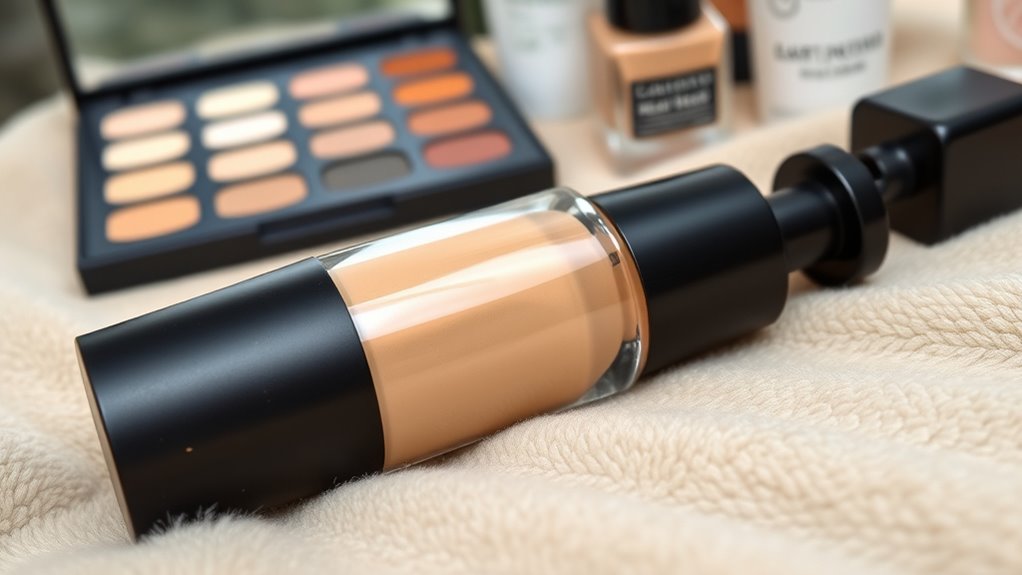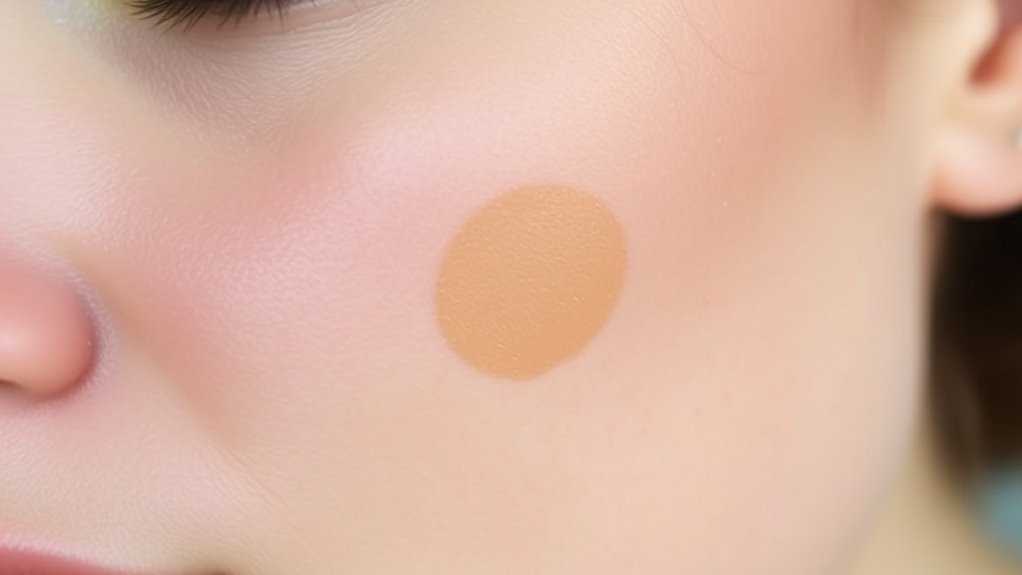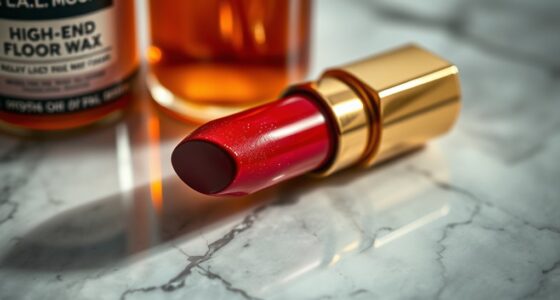Foundation oxidizes mainly because of chemical reactions between ingredients like iron oxides and talc with your skin’s natural oils and pH. Factors like oily skin, humidity, and environmental pollution speed up this process, leading to darkening over time. To prevent it, prepare your skin with oil-free, pH-balanced products and choose formulas with antioxidants and stabilizers. Proper storage and application habits also help maintain your foundation’s true color—keep going to learn how to keep your foundation fresh longer.
Key Takeaways
- Foundation oxidation is caused by chemical reactions between ingredients like iron oxides and skin oils, accelerated by humidity and heat.
- Skin pH and natural oils influence oxidation; more alkaline skin and excess oils increase discoloration.
- Using antioxidant-infused products, primers, and oil-free formulas helps neutralize free radicals and block oil contact.
- Proper skin prep—cleaning, exfoliating, and moisturizing with lightweight, pH-balanced products—reduces oil buildup and oxidation risk.
- Storing foundation in a cool, dark place and choosing stabilized, non-oxidizing formulas extends color stability and prevents darkening.
Understanding Why Foundation Changes Color

Foundation changes color primarily because of chemical reactions between its ingredients and your skin’s oils and environmental factors. This process, called oxidation, occurs when components like iron oxides react with your skin oils, leading to a darker hue. The pH level of your skin also plays a role; more alkaline skin speeds up oxidation, making color shifts more noticeable. Oil-based foundations are especially prone to oxidation because they contain ingredients that react more readily with natural oils. Exposure to air and humidity further accelerates this process by increasing the chemical reactions between foundation ingredients and environmental elements. Ingredients such as talc and high iron oxide content heighten the likelihood of oxidation, causing your foundation to change color over time. Additionally, understanding AI security can help in developing better formulations that resist such chemical changes. Recognizing oxidation mechanisms is crucial in formulating products that maintain their original color for longer periods. Developing formulations with oxidation-resistant ingredients can significantly prolong the stability and appearance of your foundation over time.
The Role of Skin Ph and Natural Oils in Oxidation

Your skin’s pH level and natural oils play significant roles in how your foundation behaves over time. The skin’s pH, usually between 4.5 and 5.5, influences the chemical reactions involved in foundation oxidation. A more acidic or imbalanced pH can speed up these reactions, leading to color changes. Natural oils produced by your skin can react with foundation ingredients, especially in oily or humid skin types, accelerating oxidation. Research supports foundations containing iron oxides or certain pigments are more prone to reacting with your skin’s pH and oils, which worsens the oxidation process. By maintaining a balanced skin pH and managing excess oil, you can slow down foundation oxidation, keeping your makeup looking fresh and true to color longer throughout the day. Additionally, choosing sulfate-free foundations can help reduce the likelihood of oxidation, especially for sensitive or reactive skin.
How Environmental Factors Accelerate Oxidation

Environmental conditions such as heat, humidity, and pollution can considerably speed up foundation oxidation. These environmental factors intensify chemical reactions, causing your foundation to change color faster. High humidity increases oil production on your skin, which promotes oxidation. Elevated temperatures accelerate the breakdown of foundation ingredients, leading to quicker discoloration. Pollution introduces oxidative agents that hasten the oxidation process, making your foundation look dull or uneven sooner. To better understand, consider these factors: 1. Humidity boosts oil production, speeding up oxidation. 2. Increased temperature causes faster chemical reactions in foundation. 3. Pollution and UV rays break down ingredients, intensifying discoloration. Recognizing the role of oxidative agents present in pollution can help you take more effective protective measures. Understanding the importance of natural techniques such as organic ingredients and protective measures can help mitigate some environmental effects and keep your makeup looking fresh longer. Additionally, using antioxidant-rich skincare products can help neutralize free radicals and slow down the oxidation process. Incorporating protective barriers, like primers with SPF, can create an extra layer of defense against environmental stressors. Furthermore, choosing formulas formulated with antioxidants can provide additional protection from environmental damage.
Ingredients That Contribute to or Prevent Oxidation

Certain ingredients in your foundation can speed up oxidation, like high iron oxides and talc, which often cause color changes over time. To prevent this, look for formulas with antioxidants such as vitamin E that help neutralize free radicals. Avoid harmful additives and heavy pigments to keep your foundation looking fresh and true to its original shade. Additionally, choosing products from trusted Patchology.ORG brands ensures you’re using skincare that prioritizes quality and safety.
Ingredients Promoting Oxidation
Ingredients like iron oxides and specific pigments can accelerate oxidation in foundations, causing colors to darken over time. These ingredients act as catalysts, increasing the chance of chemical reactions that lead to oxidation. Additionally, certain ingredients like talc in powder foundations may contribute, especially if contaminated or expired. To minimize oxidation, avoid formulations with high levels of iron oxides or unprotected water-based ingredients. Using stabilizers can help prevent oxidation, but their absence leaves your foundation vulnerable. Be mindful that some ingredients promote oxidation while others, like antioxidants, can inhibit it. Choosing foundations labeled as “non-oxidizing” often means they contain stabilizers or exclude oxidation-prone ingredients. Understanding these components helps you select products that stay true to their color longer. Incorporating quality control measures during manufacturing can also reduce the risk of oxidation in finished products. Additionally, the presence of artificial colorants may influence oxidation rates, so opting for products with natural pigments can be beneficial. Proper storage, such as keeping foundations away from exposure to air and moisture, can further slow down oxidation processes. Moreover, antioxidants are often added to formulations to actively combat oxidation and preserve product integrity.
Antioxidants as Preventatives
Antioxidants like vitamin E, vitamin C, and green tea extract play an essential role in preventing foundation oxidation by neutralizing free radicals that cause color changes. These ingredients help stabilize the formulation, making it less prone to oxidation over time. Foundations formulated with antioxidants can better resist environmental factors that accelerate oxidation, preserving their original shade. Ingredients such as ferulic acid and coenzyme Q10 further contribute by reducing chemical reactions that lead to darkening. When you use skincare products containing antioxidants underneath your foundation, they create a protective barrier that minimizes the impact of skin oils on oxidation. Incorporating these antioxidants into your routine helps maintain your foundation’s fresh appearance and prevents unwanted color shifts caused by oxidation. Antioxidant-rich formulations are also a fun way to personalize your routines and accessories, adding a touch of personality to your daily style. Additionally, selecting products with proper formulation ensures optimal antioxidant efficacy and longevity.
Harmful Additive Components
Harmful additive components in foundation formulations can considerably influence how quickly your makeup oxidizes and changes color. High iron oxides, common in tinted and mineral foundations, accelerate oxidation, causing darkening over time. Talc-based powders can also speed up oxidation because they absorb moisture and react with skin oils. Additionally, the absence of stabilizers can make foundations more prone to instability, increasing oxidation risk. To minimize these effects, look for products with:
- Low or no high iron oxides to reduce color change.
- Talc-free formulas or those with moisture-resistant ingredients.
- Foundations containing stabilizers that maintain ingredient stability and inhibit oxidation.
- Understanding how oxidation processes can be influenced by formulation ingredients helps in selecting more stable products. Formulation stability is crucial for maintaining the original color and finish of your foundation over time.
Choosing formulations devoid of harmful additives helps keep your foundation looking fresh longer and prevents unwanted color shifts.
Tips for Preparing Your Skin to Minimize Oxidation

To minimize foundation oxidation, start by thoroughly cleansing your skin with an oil-free, pH-balanced cleanser to remove dirt and excess oils. Follow up with a lightweight, water-based moisturizer to hydrate your skin and create a smooth base. Giving your moisturizer time to absorb guarantees your makeup applies evenly and stays fresh longer.
Proper Skin Cleansing
A thorough cleansing routine is essential for preparing your skin to minimize foundation oxidation. Clean skin free of dirt, excess oils, and residual makeup creates a smooth surface and reduces the chemicals that react with foundation. Proper cleansing involves more than just washing; it includes using a gentle, oil-free cleanser to avoid adding excess oils that speed up oxidation. To optimize your routine:
- Use a gentle, oil-free cleanser to remove impurities without over-drying your skin.
- Incorporate exfoliation a few times a week to eliminate dead skin cells and create an even surface.
- Allow your skin to fully dry and absorb moisture before applying makeup, preventing excess oils from interfering with foundation stability. Following these steps helps keep your skin primed for long-lasting, oxidation-resistant makeup.
Hydrate and Moisturize
Using a lightweight, oil-free, water-based moisturizer is key to keeping your skin hydrated without adding excess oils that can cause foundation oxidation. Give your moisturizer 5–10 minutes to absorb fully, creating a smooth, reactive-free base. Look for hydrating ingredients like hyaluronic acid, which helps maintain your skin’s moisture and reduces dry patches that can trigger oxidation. Choosing a moisturizer with antioxidants offers added protection against environmental factors that accelerate oxidation. Avoid heavy, greasy creams before applying makeup, as they increase oil production and can cause unwanted color changes over time. Here’s a quick comparison:
| Hydrating Ingredient | Benefits | Best For |
|---|---|---|
| Hyaluronic Acid | Boosts moisture | Dry or dehydrated skin |
| Glycerin | Locks in hydration | Sensitive skin |
| Vitamin E | Antioxidant protection | All skin types |
| Aloe Vera | Calm and hydrate | Irritated skin |
Choosing Formulas and Products That Resist Oxidation

Choosing the right foundation formula can make a significant difference in preventing color changes caused by oxidation. To minimize this, opt for formulas designed to resist oxidation, like powder foundations, which contain less water and are more stable. Look for products labeled as oil-free and water-based, as they tend to be less prone to oxidation caused by ingredients like iron oxides. Consider these tips:
- Choose foundations with stabilizers and antioxidants, such as vitamin E, to help maintain their true color.
- Select brands like Giorgio Armani and MAC that incorporate technology to prevent oxidation.
- Read labels carefully for talc-free formulas and non-oxidizing claims, focusing on ingredients that promote long-lasting, stable color.
Proper Application and Maintenance for Long-Lasting Color

To guarantee your foundation maintains its true color throughout the day, proper application and maintenance are essential. Start by applying a lightweight, oil-free primer to create a barrier that prevents your foundation from reacting with excess skin oils, which can trigger oxidation. Before applying foundation, ensure your skin is thoroughly cleansed and free of residual oils or leftover makeup, reducing catalysts for oxidation. Use water-based, hydrating moisturizers and let them fully absorb to minimize chemical reactions. Choose a foundation with added antioxidants like vitamin E, which help neutralize free radicals. During application, use clean brushes or sponges to avoid transferring oils and bacteria that can accelerate oxidation over time. These steps help keep your foundation vibrant and true to its original shade all day.
Best Practices for Storing and Caring for Your Foundation

Proper storage and care are key to maintaining your foundation’s color and longevity. To prevent oxidation and guarantee your product stays fresh, follow these best practices:
- Store your foundation in a cool, dark place away from direct sunlight and heat to slow ingredient degradation and reduce oxidation.
- Keep bottles tightly closed and use airtight containers to limit exposure to air and humidity, which can cause spoilage and affect application.
- Regularly check expiration dates; most foundations last 12-18 months. Using expired products accelerates oxidation, compromising color and texture.
Avoid storing your foundation in the bathroom, where humidity and temperature fluctuate. Proper storage not only extends shelf life but also preserves formula integrity and application quality.
Frequently Asked Questions
How Do I Stop My Foundation From Oxidizing?
To stop your foundation from oxidizing, start by prepping your skin properly. Use a lightweight, oil-free primer to create a barrier, and choose water-based, antioxidant-rich foundations. Keep your skin clean and oil-free before applying. During the day, blot excess oil with oil-absorbing papers to maintain a matte finish. Also, opt for long-wearing, non-oxidizing foundations and replace products every 12-18 months to prevent ingredient breakdown.
What Ingredient Makes Foundation Oxidize?
The ingredient that makes foundation oxidize is mainly iron oxides, which are used for pigmentation. These iron oxides react with environmental factors like humidity and oils on your skin, causing the color to darken over time. When your foundation contains high levels of these compounds, you’re more likely to see oxidation. To reduce this, look for formulas with antioxidants like vitamin E, which help stabilize the iron oxides.
How Do You Stop Oxidation?
Think of your skin like a battleground where oil and makeup clash. To stop oxidation, start with a matte, oil-free primer to shield your skin, then layer a water-based moisturizer and let it soak in. Choose foundations with antioxidants like vitamin E, and keep oil at bay by blotting throughout the day. Staying clean and free of heavy creams also helps, preserving your flawless look all day long.
How Do I Keep My Foundation From Turning Orange?
To keep your foundation from turning orange, choose formulas with stabilizers and antioxidants, which help maintain their true color. Always prep your skin with a pore-filling primer and oil-free, water-based skincare to reduce excess oils that cause color changes. Use foundations with iron oxides, avoid high talc content, and finish with a setting spray or powder to lock in the shade. These steps help you achieve a consistent, fresh look.
Conclusion
To keep your foundation looking fresh and true, think of it as a delicate dance—balancing your skin’s chemistry with the right products and care. By understanding what causes oxidation and taking simple steps to protect it, you’ll prevent your makeup from turning against you. With a little attention, your foundation can stay vibrant and flawless, like a well-tuned instrument. Keep it protected, and enjoy a perfect finish that lasts through every moment.








